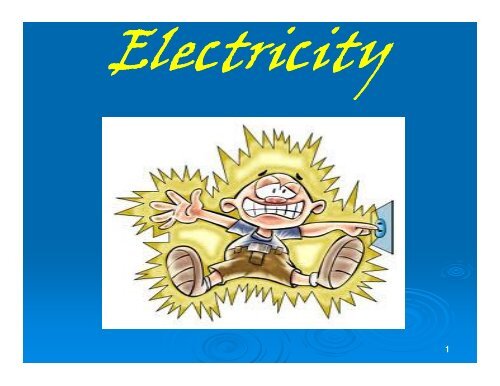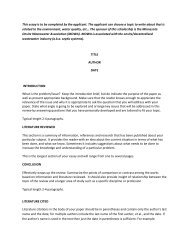Electricity - MOWA
Electricity - MOWA
Electricity - MOWA
You also want an ePaper? Increase the reach of your titles
YUMPU automatically turns print PDFs into web optimized ePapers that Google loves.
<strong>Electricity</strong><br />
<strong>Electricity</strong><br />
1
Tom Fritts<br />
tom@residentialsewage.com<br />
2
Troubleshooting<br />
Minnesota code??<br />
Selling the system<br />
Why this class??<br />
Know how to calculate usage cost for the<br />
homeowner<br />
Minimize the surprises<br />
You are responsible.<br />
3
Learning objectives<br />
<strong>Electricity</strong><br />
Basic electric current<br />
Voltages<br />
How to calculate cost of electrical usage<br />
4
<strong>Electricity</strong><br />
Basic Electric Current<br />
It is estimated that over 75% of the service<br />
calls for onsite systems are related to an<br />
electrical problem<br />
A good understanding of basic electricity is<br />
one of the most important assets an onsite<br />
contractor can have<br />
5
<strong>Electricity</strong><br />
Basic Electric Current<br />
The 4 most basic elements of electricity<br />
Volts<br />
Amps<br />
Ohms<br />
Watts<br />
6
<strong>Electricity</strong><br />
Basic Electric Current<br />
Electrons in a wire are like water in a pipe<br />
7
Volts olts<br />
<strong>Electricity</strong><br />
Basic Electric Current<br />
The smallest part of electricity is the electron<br />
8
Volts olts<br />
<strong>Electricity</strong><br />
Basic Electric Current<br />
Electrons have no problem moving through<br />
wires or conductors…….BUT<br />
The all have a negative charge…..They are all<br />
pushing against each other<br />
All the electrons pushing against each other<br />
creates a pressure we call volts<br />
9
<strong>Electricity</strong><br />
Basic Electric Current<br />
This is like water in a pipe<br />
The supply line to your bathroom fixtures<br />
carries water under a certain amount of<br />
pressure<br />
With water we measure this in PSI or pounds<br />
per square inch<br />
In electricity it is measured in volts<br />
10
Amperage<br />
<strong>Electricity</strong><br />
Basic Electric Current<br />
If a volt is the pressure of electricity then<br />
an amp is the flow of electricity<br />
The flow is also referred to as the current<br />
11
<strong>Electricity</strong><br />
Basic Electric Current<br />
With a valve we can shut off the flow of water<br />
……The valve is just like a switch<br />
With a switch we can shut off the flow of<br />
electrons or current or amperage<br />
12
<strong>Electricity</strong><br />
Basic Electric Current<br />
But what exactly is amperage?<br />
Amperage is the amount of electrons flowing<br />
past a point in a given amount of time<br />
Doesn't this sound like the flow of water in a<br />
pipe……… Gallons Per Minute(GPM)<br />
13
<strong>Electricity</strong><br />
Basic Electric Current<br />
Increasing the size of a pipe will allow more<br />
gallons per minute past a certain point<br />
Same with electricity<br />
Increasing the size of a wire will allow more<br />
electrons past a certain point<br />
BUT<br />
Use a smaller wire and you restrict the flow of<br />
electrons and lower the voltage to the pump<br />
Resistance<br />
14
<strong>Electricity</strong><br />
Basic Electric Current<br />
Resistance<br />
In electricity this resistance is measured in<br />
ohms<br />
Simple….the more ohms you have the<br />
less amps you get<br />
15
<strong>Electricity</strong><br />
Basic Electric Current<br />
Volt<br />
Defined – The unit of measurement of electrical<br />
pressure<br />
The real world ?<br />
Low voltage<br />
High voltage<br />
No voltage<br />
Wrong voltage<br />
16
<strong>Electricity</strong><br />
Basic Electric Current<br />
Amp<br />
Defined – Unit of measurement of the rate of<br />
electrical current flow in a conductor<br />
The real world ?<br />
How hard the is motor working<br />
Overloading a circuit<br />
17
<strong>Electricity</strong><br />
Basic Electric Current<br />
ohms<br />
Defined – Unit of measurement of a conductors<br />
ability to resist current flow<br />
The real world ?<br />
Continuity<br />
Heat<br />
Holding back these<br />
electrons is<br />
difficult……..and HOT<br />
18
<strong>Electricity</strong><br />
Basic Electric Current<br />
What about<br />
Watts<br />
19
<strong>Electricity</strong><br />
Basic Electric Current<br />
A watt is a unit of work done over time<br />
More watts…More work Less watts…Less work<br />
20
<strong>Electricity</strong><br />
Basic Electric Current<br />
Watts….In the real world<br />
It is the “price per gallon” of electricity<br />
21
<strong>Electricity</strong><br />
Basic Electric Current<br />
A watt is the standard measure of how<br />
much electricity is used<br />
A kilowatt is simply 1,000 watts (kilo =<br />
1,000)<br />
A kilowatt hour (kWh) is a kilowatt used for<br />
one hour<br />
22
<strong>Electricity</strong><br />
Basic Electric Current<br />
How much is this system going to cost me to<br />
operate??<br />
Most motors will not say how many watts<br />
they use but they do show the amperage<br />
they draw on the nameplate<br />
Voltage x amperage = watts<br />
23
<strong>Electricity</strong><br />
Basic Electric Current<br />
The motor is 115 volt that draws 4<br />
amps…115 x 4 = 460 watts<br />
Multiply the watts times hours used and<br />
divide that by 1,000 ( (We We pay by the kilo<br />
kilowatt watt hour hour)<br />
The motor runs 30 minutes on and 30 off<br />
for a total of 360 hours per month<br />
24
<strong>Electricity</strong><br />
Basic Electric Current<br />
Now multiplying the watts (460) times the<br />
hours used in a month (360)<br />
460 x 360 = 165,600 watts (not kilowatts)<br />
165,600 / 1,000 = 165.6 kilowatt hours<br />
$<br />
25
<strong>Electricity</strong><br />
Basic Electric Current<br />
KCP&L charges .08 / kilowatt hour<br />
165.6 x .08 = $13.25 per month<br />
Is this a lot ??<br />
26
<strong>Electricity</strong><br />
Basic Electric Current<br />
An 18 Cu Ft frostless refrigerator uses<br />
about 615 watts and run an average of<br />
325 hours per month<br />
325 x 615 = 199,875 watt hours per mo<br />
199,875 / 1,000 = 199.875 (200) Kwh<br />
200 x $0.08 = $16.00 per month<br />
27
<strong>Electricity</strong><br />
Voltages<br />
Voltage choices<br />
115 Single phase<br />
230 Single phase<br />
208 Three phase<br />
28
115 Volts<br />
<strong>Electricity</strong><br />
Voltages<br />
The most common voltage around the house<br />
29
115 Volts<br />
<strong>Electricity</strong><br />
Voltages<br />
A 115 volt circuit would commonly have 3<br />
wires, or leads as referred to by electricians<br />
• Black lead – referred to as the hot<br />
• White lead – referred to as the neutral<br />
• Copper lead – referred to as the ground<br />
NOTE….It ….It is a real good idea to not change colors when<br />
doing repairs<br />
NOTE<br />
Each one of the leads with the exception of<br />
the ground would be enclosed in insulation<br />
30
115 Volts<br />
<strong>Electricity</strong><br />
Voltages<br />
The three leads with 2 insulated and 1 bare<br />
would then be enclosed in a non conductive<br />
insulation that we commonly call “ “romex romex”<br />
Romex is a brand name for a type of plastic<br />
insulated wire<br />
The formal name is “non “non-metalic metalic sheath” or<br />
NM<br />
31
115 Volts<br />
<strong>Electricity</strong><br />
Voltages<br />
Most new homes are wired with NM wire<br />
where it is not exposed to mechanical<br />
damage, excessive heat or moisture<br />
In damp places ( buried wiring to a lift station)<br />
you will need special wire called UF for<br />
underground feeder<br />
32
<strong>Electricity</strong><br />
Voltages<br />
UF wire is designed to be buried directly<br />
into the earth with no conduit..However<br />
there is a major problem with all plastic<br />
wire<br />
Landscape lighting<br />
Sprinkler wiring<br />
Trees and shrubs<br />
Roto Roto-tilling tilling<br />
33
<strong>Electricity</strong><br />
Voltages<br />
Most building codes suggests that all UF<br />
wire be buried to a depth of 18 inches<br />
Best practice would be to run it in conduit<br />
What is another advantage of conduit??<br />
34
230 Volts<br />
<strong>Electricity</strong><br />
Voltages<br />
This is the voltage around the house that<br />
would power things such as air conditioner,<br />
clothes dryer and oven<br />
35
230 Volts<br />
<strong>Electricity</strong><br />
Voltages<br />
So what is the big deal with 115 and 230 ? It<br />
seems confusing that pumps / motors can<br />
run on either voltage.<br />
If 115 is so common why would I ever want<br />
to use 230 volts ?<br />
36
<strong>Electricity</strong><br />
Voltages<br />
When you use a 230 volt pump the amp<br />
draw is ½ that of the 115 volt pump with<br />
comparable curves<br />
This means the power wire can be twice<br />
as long with equal line loss as the 115<br />
37
<strong>Electricity</strong><br />
Voltages<br />
Let’s say we have a 115 volt pump that<br />
draws 9 amps<br />
Let’s also say we are installing this pump<br />
100 feet from the main control panel using<br />
12 / 2 UF wire ( (The The most common used )<br />
See any problems?<br />
This is the worst kind of failure…A “soft”<br />
failure<br />
39
<strong>Electricity</strong><br />
Voltages<br />
Now take a look at the same installation<br />
using a 230 volt pump<br />
See how the 115 volt pump requires you<br />
to step up to #10 wire to prevent line loss<br />
or low voltage<br />
But using a 230 volt pump is well within<br />
the range of #12 wire<br />
40
<strong>Electricity</strong><br />
Voltages<br />
The mysterious<br />
3 phase<br />
208 Volts<br />
What do you do ??<br />
41
Go Fishing !!!<br />
42
You can sit<br />
all day and<br />
work on a<br />
panel like<br />
this one<br />
43
Incoming power to<br />
the pump<br />
Usually 12/2 UF<br />
wire<br />
Basic time dose control panel<br />
44
Incoming power to<br />
the panel<br />
Usually a smaller<br />
gauge wire like<br />
14/2 UF<br />
Basic time dose control panel<br />
45
Pump power to the<br />
relay<br />
Basic time dose control panel<br />
Pump power from the relay<br />
to the pump<br />
46
Basic time dose control panel<br />
20 Amp breaker<br />
Timer<br />
High water alarm<br />
float<br />
Low level cut off<br />
float<br />
47
Did anybody notice<br />
this ?<br />
What could be<br />
the cause ?<br />
Probably this<br />
Basic time dose control panel<br />
48
Notice the<br />
difference in the<br />
color of the<br />
brass lug<br />
screws ?<br />
This is from the<br />
heat caused by<br />
the loose<br />
connection<br />
Basic time dose control panel<br />
49
Incoming power<br />
supply from<br />
house<br />
Outgoing<br />
power to pump<br />
and float leads<br />
from tank<br />
Take a look<br />
where these<br />
leads enter the<br />
tank<br />
Basic time dose control panel<br />
Panel<br />
mounted on<br />
sturdy unistrut<br />
extending<br />
along side the<br />
tank to a<br />
Note: All leads are in conduit attached to the panel with watertight hubs<br />
and penetrating the panel in the bottom maintaining the NEMA 4 rating<br />
depth of 5 feet<br />
minimum<br />
50
Basic time dose control panel<br />
Power to pump and float leads maintaining good watertight<br />
connections from the panel to the tank<br />
IMPORTANT: Don’t forget to seal the tank gasses from the panel<br />
51
Basic time dose control panel<br />
Ready<br />
for<br />
backfill<br />
52
Questions<br />
53









